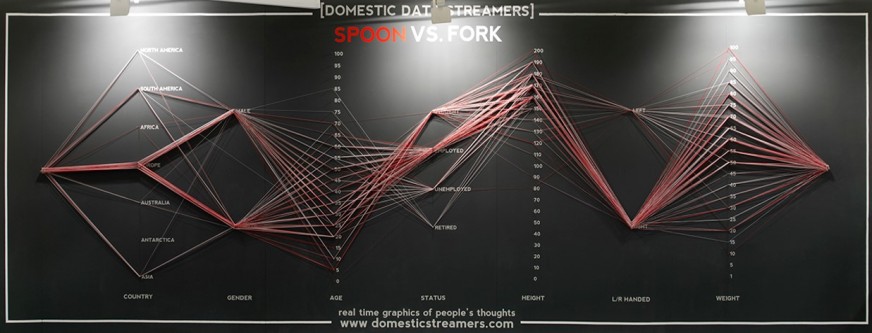DATA
ART

Spoon VS. Fork
Location: Swab Contemporary Art Fair. Barcelona.
Date: 03/06/13
This experiment would start with the subject having to choose between a spoon and a fork, the answer to this would determine the colour string the subject would use; red for spoon and white for fork. All string would start at one point and as they went along the board they would have to answer questions that would split them off and tell everyone apart.
What continent are you from?
What is your gender?
How old are you?
What is your employment status?
How tall are you?
Are you left or right handed?
How much do you weight?
As more people would answer these questions the board would fill up and create art from the data collected.
This data art project was produced and displayed in the Swab Contemporary Art Fair which is in Barcelona. The annual art fair started back in 2006 and is still going today. Not only was Swap open to 52 galleries in the world it also encouraged young artists, this meant students could showcase their work in a professional environment, which was very interesting to us as a group as young artists.
The company Domestic Data Streamers are responsible for the Spoon Vs. Fork project at the Swab Contemporary Art Fair back in 2013. The idea behind this project was to put real life graphics of people’s thoughts and turn it into art, referred to as data art. Domestic Data Streamers explained “We will generate a real time infographic that shows a range of human profiles from age, to origin and professional status.” This allowed the Domestic Data Streamers to find their audience as well as finding the Swab Contemporary Art Fair audience.
As a group we decided to choose this data art project because the look of it in data art form was appealing and therefore intrigued us to find out the reason behind the pattern as well as how they collected this information. This project inspired us because it comes from such a simple idea yet the creation of art is effective and simplistic in showing us the audience visiting the exhibition. As a group we thought that this project was relatable because we considered this as a project we could conduct ourselves on a smaller scale and with a similar data art production.
Flint, Michigan water pipes were polluted by lead in the system since the city decided to switch from Detroit waters systems to a backwards flint river as its water source in 2014. This resulted in a mass health crisis which predominantly affected kids of that area. According to the World Health Organisation, leads affects children’s brain development resulting in a reduced IQ, shortened attention span, hypertension, renal impairment and many more.
Paris climate talks
More than 150 world leaders have converged to launch the two week talk, known as COP21. Most of the discussions are expected to centre on an agreement to limit global warming to 2C (3.6f).
read more here: http://www.bbc.co.uk/news/science-environment-34963048
read more here:
https://www.washingtonpost.com/news/morning-mix/wp/2015/12/15/toxic-water-soaring-lead-levels-in-childrens-blood-create-state-of-emergency-in-flint-mich/
Same-sex marriage now legal as first couple wed
The first same-sex weddings have taken place after gay marriage became legal in England and wales at midnight.
read more here: http://www.bbc.co.uk/news/uk-26793127
If you’re in the mood for outrageous injustice stories find out more here: http://injusticestories.com/
http://swab.es/en/web/about-swab.html
https://www.behance.net/gallery/11492915/Spoon-vs-Fork-Data-Visualizer
http://domesticstreamers.com/2014/project/data-strings/
JUSTICE
SOCIAL
Since the dawn of the internet it’s been easier for people to share their examples of social justice and injustice. These can be personal stories or events that affect a vast number of people. Just by searching across the web we came across a number of examples that have occurred across the world.
These articles were chosen because they are topics which affect a huge number of the population. These issues range from discrimination of the minority groups; of lower class societies and abuse of the environment. These are subjects that affect us personally and always create conversation. We wanted to showcase some of our stand out social justice stories.